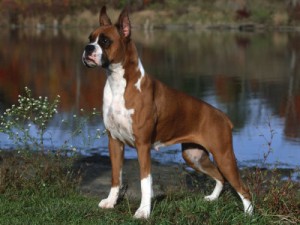 The Boxer is a German breed that was created by crossing a Bullenbeisser, an unknown breed, and an English Bulldog. This breed was originally very aggressive and used for fighting and baiting bulls. However, over the years this breed lost their aggressiveness and it has become better suited for family life. With proper training the Boxer can make an excellent companion for adult and child alike. Be prepared, though, as they often have a very high level of energy.
The Boxer is a German breed that was created by crossing a Bullenbeisser, an unknown breed, and an English Bulldog. This breed was originally very aggressive and used for fighting and baiting bulls. However, over the years this breed lost their aggressiveness and it has become better suited for family life. With proper training the Boxer can make an excellent companion for adult and child alike. Be prepared, though, as they often have a very high level of energy.
The boxer is a mid-sized dog breed that typically stands between 21 and 25 inches tall. They are noted for their muscularity and gorgeous appearance. They usually weigh between 66 and 70 pounds. Their coat is short, smooth and shiny. Their coat can come in a variety of colors and have several different marking patterns. Some of the most common colors Boxers have include white, brindle, and fawn. Although they have short fur they still do shed, although it may be less noticeable due to its length.
Boxers are affectionate and playful breeds. Their past may indicate ferociousness but their general temperament of todays breed is rather friendly and welcoming.
Boxers are one of the most popular breeds of dog today.
Origin of the Boxer
Boxers were developed in Germany and they are believed to have been descended from the Bullenbeiszer and the Barenbeiszer, two German mastiff type of dogs. Later they were crossed with bulldogs and a few other ancient mastiffs.
 They were once used in the violent game of bull baiting, for pulling carts because of their strength and as a hunting companion.
They were once used in the violent game of bull baiting, for pulling carts because of their strength and as a hunting companion.
This breed is relatively new and it wasn’t until 1904, when the first Boxer studbook was created, that breed standards were finally established. The name “Boxer” came from the earlier fighting instincts of the breed.
Early Boxers were indeed ferocious because they were mainly bred for viciousness but nowadays they are gentle and obedient breeds. They have versatile uses and they are now prized for companionship.
Boxer Appearance and Abilities
Boxers are solidly built and compact. They look powerful and muscled. They have round, powerfully built necks and do not have any dewlap. There are two types of Boxers to consider, the larger and more muscular German type and the American type of boxer.
The most distinctive feature of the Boxer is its head. It must be perfectly proportioned to the body and above all it must never be too light. They also have powerful jaws ideal for hanging on to large prey.
They close-fitting coats that come in fawn, brindle, white and various shades of red, with white markings. Boxers’ tails are carried high
Temperament and Tendencies of the Boxer
Boxers are active dogs. They are playful and high-spirited. Their physicality can be quite overwhelming but they are loyal, affectionate, and obedient. In fact, they are great dogs for obedience competitions. Boxers are very eager to please and have remarkable intelligence.
Surprisingly, they love and get along well with children. They also get along with other canines and cats as well if properly socialized. Game-like animals however, are too tempting for Boxers. However, they tend to get boisterous and jump at people. Calm training is a must for Boxers.
They tend to paw things such as toys and food. This is another reason why they may have been named Boxers. Boxers seem punch everything they touch with their paws. This habit may make them seem funny and clown-like.
Boxers are courageous animals and they will protect their masters when threatened.
Boxer Training and Care
Leadership is the key to managing Boxers. The objective in training this breed is to achieve a pack leader status. So, as a member of the pack, owners must take the role of the alpha dog. Meekness and inconsistency will make the Boxers believe that they hold the alpha role. When this happens, the Boxer is demanding, stubborn, and boisterous.
Never allow Boxers develop dominance problems. Any signs of dominance need to be immediately corrected by the owners in a calm, but firm, confident way.
Boxers require daily walks and occasional plays such as fetching things. So, apartment living is okay as long as you can give them adequate physical and mental stimulation.
Boxers are naturally clean dogs. They clean themselves like a cat does. Grooming their short smooth coats is very easy. Bathe only when necessary. Don’t give too much bathing because it removes natural oils from their skin.








20 Responses to “How to Train a Boxer Dog”
I love the boxer pic! I grew up with boxers and they are the best dog hands down. The only pets we have right now are bnenius and I do not foresee a dog in our future but if we ever get one it will definitely be a boxer! We had a couple of brindle ones like the one on the back of your couch, so cute!!
my cousin used to have 12 boxers
i have a 7 months boxer and i want him to be ferosious but he s getting friendly to every one which i dont want him to be so please suggest me to train him…….
I’m not going to help you with something like this. You really shouldn’t own a dog.
Why do you want you dog to be mean??? A sweet & friendly dog will protect you in the same way a mean dog will & will be a dog that you can actually enjoy. We just adopted a 2yr old Brindle Boxer (5 days ago) & she alreadly gaurds our yard as if she’s beeen here her whole life & she’s also already very protective of my 5 children. I think this is a common & a very sad mistake that people make about dogs.
Opps…. Your….. Been
I have a 13 month old boxer and he is friendly to everyone as well BUT if he feels threatened or is unsure of someone at the door he will put himself in between me and whoever is at the door. He does growl at movements that he doesnt recognize out the windows at night. You dont want your dog to be trained to be mean. That can and most likely will backfire on you. Let him become protective on his own. He knows who takes care of him.
i have a boxer and he is a great dog love him to death… im about to be liven with a friend and he has a lab and i want them to get along any suggestions
I have a 6 year old lab and a 2 year okd boxer and they get along great!! My lab has just as much energy as the boxer so its a great match!!
HI i have 2 male boxers 5 and 6 years old don’t get me wrong i love them both we exercise everyday about an hour to two hours daily and they get along with me just fine and my 8 month year old son but my wife not to well they start barking and growling at her when she trys to feed them or give them water when im not around , but when I am around with her they are nice and dont do anything so any tips on training them better well help thanks….
Truthfully, you are in a position where you need a lot more than tips. If your dog is growling and barking at your wife then you need some intensive training, you are well beyond the ‘tips’ phase.
my boxer tried to bite my father in law cud he moved to fast haw can i Tran him not to do that he is 6 months old and 26 inc tail please help me
hi everyone
i have question
we own pure breed black and white boxer, he is 2 years old ..we still have people coming us to saying that not pure breed boxer.. because of his colour…
how do i get him to stop jumping up on people..
You need to correct him for jumping on people.
I have a black and white boxer as well….. are they pure bred or not? i have the papers saying he is a pure bred, but why would ppl say that black and white are not pure?
I have a 2 1/2 year old male boxer, Ty, who has been friends with our cat, Marley, for over a year and got on a like a house of fire. We have recently addopted Ty’s brother, Diesel, who is just 1 year old and been with us for 6 weeks. Now the two dogs hate Marley and yesterday they both held Marley down with a view to really hurting him and I had to separate them. Please please someone give me some positive feedback on how to make them all get on.
The best thing to do for dogs who like to go after cats is simple e-collar training to correct them as they even begin their ‘hunt’.
I have a 13 1/2 month old boxer who is becoming a very well behaved dog in most ways. The problem I have is that recently he keeps jumping up at people when he thinks they have something for him, ie- treats,toys etc…(they dont always have something) , as he is pretty big now, it can be VERY overwhelming for others when he suddenly does this. He tends to focus on something & jumps to get it. He doesn’t jump on people when he meets them,(that stopped months ago) but does when playing n& gets excited. How can I stop this, especially if he is a small distance away from me, as I don’t want it to become a problem. He doesn’t tend to act like this with myself or my partner.
I just got my first boxer and he is a good dog but he lacks training I’ve been trying to train he myself all I really want him to do is come when I want him to sit and stay but when I try he seems to get scared and runs from me and that after a while got me mad so I spanked him for it and that just made it worse do you have any tips
you should always be consistent. boxers are very stubborn but very smart. it may seem like small tasks for you, but it may take as much training as a roll over command depending on u, not the boxer. if you saty consistent, he will learn, if not he will not learn. never call him to come and do something he does not like, as in bath, scold, cut nails, or ignore him. only call him to come wen u have treat or toy to reinforce with. he will soon see that good thing come wen u call him to come. use short quit words like, sally, come or sally here…. and praise and get excited wen he is even just begining to come, if he turns his back, u turn your back and walk out of the room. return and try it again. dont keep saying come, here or call his name while he is not listening or is distracted, this will only teach him to ignore his name and you. good luck!!! oh, and the most important thing about training is your patience…. and you shud never hit your dog, it will teach him to get physical with you too